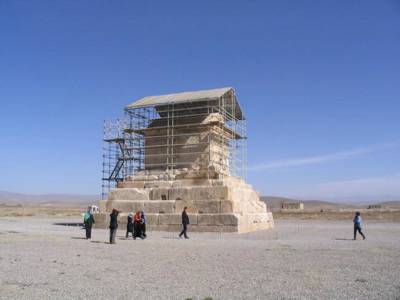The Tomb of the biblical king Cyrus at Pasargadae

the tomb of king Cyrus
"O man, whoever you are and wherever you come from, for I know that you will come--I am Cyrus, son of Cambyses, who founded the Empire of the Persians and was king of the East. Do not grudge me this spot of earth which covers my body."
- Cyrus
This tomb of the great Persian ruler, Cyrus, was discovered in 1951 at the ruins of Pasargadae (south-central Iran). Over 2500 years old, the tomb is in decent condition, made of white limestone and stands a total of 36 feet high. The tomb itself is 18 feet high resting on a 6 level base, also 18 feet high. It was built like a Ziggurat with Ionian and Lydian features. There is a small entrance and double doors leading to a room with no windows which once contained the "golden sarcophagus" of Cyrus, it is now an empty shell. Five huge stones make up its roof, which was slanted (gabled) to shed heavy rains. These Nordic gables were the architectural style of lands far to the north. The inscription was seen and recorded by Plutarch in AD 90.
Cyrus II, the Great was the founder and ruler of the vast Persian Empire from 539 B.C. until his death in 530 B.C. Once Cyrus had defeated the Median king, Astyages and took Ecbatana he expanded his kingdom defeating Croesus, king of Lydia in 546 BC, and then conquered Babylon in 539 BC, and the Persian Empire was formed. He was a generous ruler allowing various captives to return to their homelands, as recorded on the Cyrus Cylinder. Xenophon, Nabonidus and many others gave Cyrus praise for his generous leadership.
The Decree of Cyrus - Judea had remained a Persian province for the next two hundred years until the time that the Bible records "the decree of Cyrus" giving permission to the Hebrew captives to go back to Jerusalem to rebuild their Temple. Much is mentioned about Cyrus in the Old Testament.
Isa 41:25; 44:28; 45:1-13; Ezra 1:1-11; 4:3-5; 2 Chron 36:22-23; Dan 1:21; 10:1.

0 Comments:
Post a Comment
<< Home